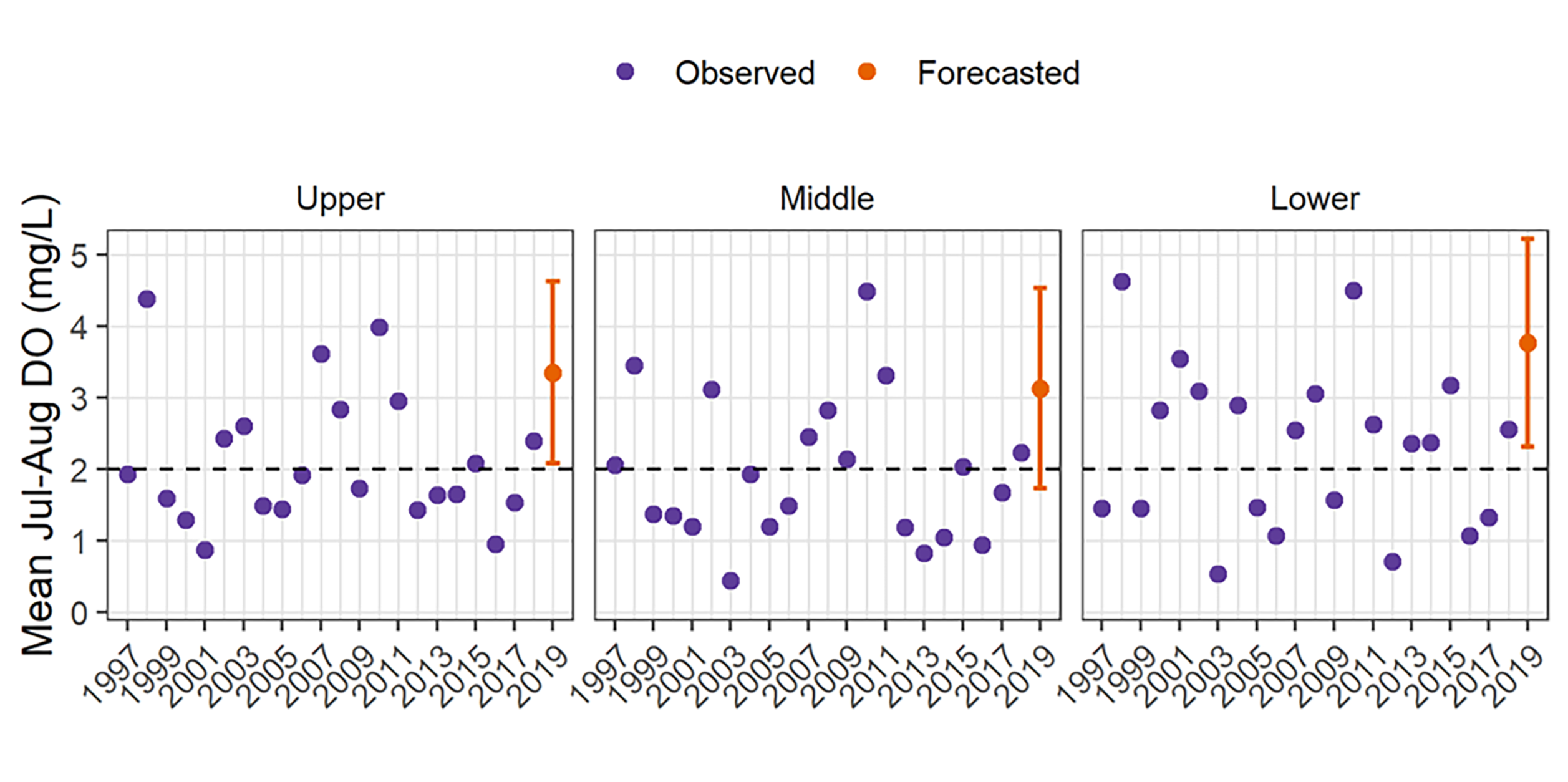Researchers Forecast Healthier Neuse River Oxygen Levels

Contact:
Katie Mosher, kmosher@ncsu.edu, 919-515-9069
Scientists at North Carolina State University and the University of North Carolina at Chapel Hill are forecasting higher levels of dissolved oxygen this summer for the Neuse River Estuary. Compared to last summer, the predictive model indicates a smaller likelihood of stresses to the ecosystem, including fish kills.
“Our model quantifies important drivers of water quality in the Neuse River estuary, and allows us to forecast dissolved oxygen levels based on nutrient loads and flows over the preceding nine months,” says Daniel Obenour of NC State, the lead researcher on the project. “The estuary serves as an important fisheries habitat. Understanding and improving water quality is a mission-critical goal for water resource managers, fisheries managers, public officials and others.”
With support from North Carolina Sea Grant, Obenour, an environmental engineer, is collaborating with coastal ecologist Hans Paerl of the UNC-CH Institute of Marine Sciences. Last year, their team accurately predicted the Neuse would experience unusually low levels of dissolved oxygen.
“Water in the estuary stratifies into two layers — lighter surface water and denser bottom water, like Italian dressing in a bottle separates into lighter and heavier layers,” Obenour explains. “The surface layer of water contains more oxygen because oxygen-producing algae reside there, and it is exposed to the air. Like the spices at the bottom of the salad dressing bottle, algae and related organic material settle into the bottom water, where microbes feed on it and reduce the oxygen content.”
The model generates daily predictions of dissolved oxygen in these bottom waters, the Neuse River estuary’s lowest three feet. Last year, the team accurately forecasted low oxygen levels, regularly below 2.0 milligrams per liter — a critical threshold for many aquatic species. This year’s forecast, however, calls for a somewhat healthier average concentration of 3.4 milligrams per liter during the same July-to-August timeframe. (See Figure 1 below.)
Alexey Katin, a graduate student in civil engineering who works on the project, says two primary factors drive the forecast that the Neuse will be better oxygenated this summer. First, the winter and early spring were wetter than in the prior 22 years.
“The Neuse River’s discharge was almost double the usual rates for those months,” Katin explains. “These higher flows reduce algal accumulation in the upstream portion of the estuary in the winter and early spring, such that there is less build-up of oxygen-demanding organic matter.”
Second, late spring and summer discharges are expected to be below the historic average.
“Low river flows in late spring and summer generally lead to reduced nutrient loads to the estuary, especially nitrogen, which, in turn, limit summer algal production,” Katin says. “Furthermore, lower summer flows reduce stratification, allowing for more oxygen to mix into the bottom of the estuary.”
The model builds upon data that Paerl’s laboratory has collected through the Neuse River Estuary Modeling and Monitoring Project. The “ModMon” project marks 25 years this month.
“Without these extensive datasets, a model like this would not be possible,” says John Fear, deputy director for North Carolina Sea Grant and the Water Resources Research Institute, which have supported ModMon-based research over the years. “We’re pleased one of the state’s long-term monitoring datasets can help manage estuarine systems.”
At the same time, Obenour, who also has worked on predictive models for Lake Erie and the northern Gulf of Mexico, cautions about substantial uncertainty when forecasting water quality months in advance, especially in the Neuse.
“Major meteorological events can affect hypoxia in both the short and long term,” Obenour explains. “Last year’s Tropical Storm Chris and Hurricane Florence initially elevated oxygen levels, but also deposited large quantities of oxygen-demanding organic matter in the estuary. It is unclear how much of that extra oxygen demand may persist into this summer.”
Furthermore, while fish kills are often linked to extremely low oxygen levels, they also can occur for other reasons.
“A Neuse River fish kill in May was primarily linked to a fungus,” says Nathan Hall, a UNC-CH coastal ecologist also based at IMS and researches water quality topics.
Obenour says a primary purpose of the model is to improve understanding of the estuary and anticipate how it will respond to changes in nutrient loading and climate.
“We have plans to share the forecast with the public and various resource managers,” he adds. “We hope the model will enable us to raise awareness about nutrients, oxygen levels and estuarine health.”

Read about how last year’s storms affected oxygen levels: “Tropical Systems Disrupt Neuse River Oxygen Levels”
Lead photo: The Neuse River in Johnston County, North Carolina, by Ken Thomas.
###
North Carolina Sea Grant: Your link to research and resources for a healthier coast
- Categories:


